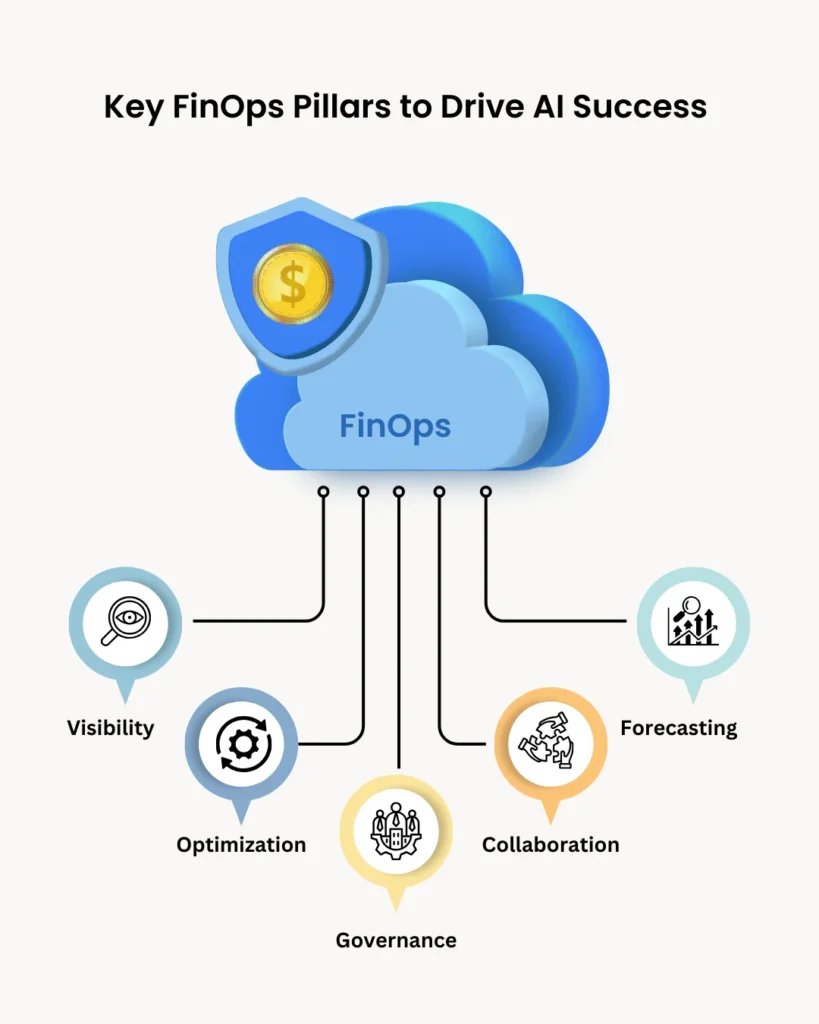Introduction
Artificial intelligence (AI) adoption is accelerating across industries, from healthcare and finance to retail and manufacturing. As businesses embrace AI for predictive analytics, automation, and generative models, cloud computing has become the backbone of this transformation; offering the scalability and flexibility required to power complex workloads.
However, the rapid growth of AI workloads is driving up cloud expenses, often unpredictably. This is where a well-defined FinOps Strategy for AI becomes critical. FinOps enables finance, engineering, and business teams to collaborate in optimizing cloud spend, ensuring financial accountability and operational efficiency as AI initiatives scale.
Table of Contents
Why AI is Driving Up Cloud Costs
AI workloads, especially large language models (LLMs) and generative AI – demand intensive computing power, large-scale storage, and frequent retraining. GPU provisioning alone can cost thousands of dollars daily, and additional expenses like inference, versioning, and data storage only add to the burden. As AI becomes mission-critical, unchecked cloud usage can lead to budget overruns.
Understanding the FinOps Strategy for AI
To address these challenges, a FinOps strategy brings financial discipline to AI-driven cloud spending. FinOps (Financial Operations) fosters collaboration between engineering, finance, and business teams, helping them track AI resource usage, set cost guardrails, and improve forecasting. With clear visibility into spending and shared accountability, businesses can scale their AI efforts sustainably – ensuring innovation doesn’t come at the cost of financial control.
Key FinOps Pillars to Drive AI Success
To make AI efforts sustainable and cost-effective, organizations need to follow a few essential FinOps Strategy for AI principles. Here are the key pillars that help teams balance innovation with financial control:

- Visibility: It all starts with knowing where your money is going. Real-time tracking of AI-related cloud usage; like compute power, storage, and networking; helps teams stay aware of how much they’re spending and why.
- Optimization: Not every AI task needs the most powerful (and expensive) setup. By right-sizing resources, using spot instances when possible, and setting up autoscaling, teams can ensure they’re only paying for what they need; nothing more.
- Governance: To prevent cloud costs from spiraling out of control, it’s crucial to put the right guardrails in place. This means defining budgets, usage limits, and access policies so that cloud spending doesn’t become a free-for-all.
- Forecasting: AI projects go through different phases—like training, testing, and deployment; and each comes with its own cost profile. With better forecasting tools, teams can predict expenses ahead of time and plan accordingly.
- Collaboration: FinOps isn’t just a finance thing; it works best when finance, engineering, and product teams all work together. With shared goals and open communication, everyone stays on the same page, and smarter decisions are made.
Aligning FinOps Strategy for AI Workloads
Successfully applying FinOps Strategy for AI workloads requires more than just a checklist of best practices; it demands strategic alignment across teams, tools, and processes. AI projects are fast-paced and resource-hungry, often evolving rapidly from experimentation to production. To keep cloud costs predictable and manageable, organizations need to embed FinOps principles directly into the AI development lifecycle. This means integrating cost considerations into every phase: from initial model training and data preparation to deployment and retraining.
For example, teams can incorporate budget thresholds into MLOps pipelines, automate cost alerts during high GPU usage, or set cost-efficiency KPIs alongside performance metrics. Alignment also means fostering a mindset shift: moving from reactive cost reviews to proactive cost planning. When engineering, product, and finance teams operate with shared visibility and joint accountability, AI workloads become not just innovative; but scalable, predictable, and financially sustainable.
Making AI Sustainable and Scalable
One of the best things about FinOps is that it doesn’t limit innovation. Instead, it gives teams the freedom to explore and scale AI initiatives with confidence. By combining cost transparency with smart governance, a FinOps strategy fosters alignment across departments, builds financial accountability, and equips teams with the insights needed to drive sustainable, budget-conscious AI growth.
Conclusion
AI is evolving rapidly, and with it, cloud costs are climbing just as fast. Without a clear strategy, businesses risk overspending and losing control. That’s why a dedicated FinOps Strategy for AI isn’t just nice to have; it’s essential. By weaving financial accountability into every phase of the AI lifecycle, organizations can make better decisions, scale with confidence, and avoid budget shocks. FinOps creates a culture of collaboration between finance and tech teams, ensuring that performance and cost-efficiency grow side by side. With the right approach, AI can be both a driver of innovation and a model of sustainable growth.











